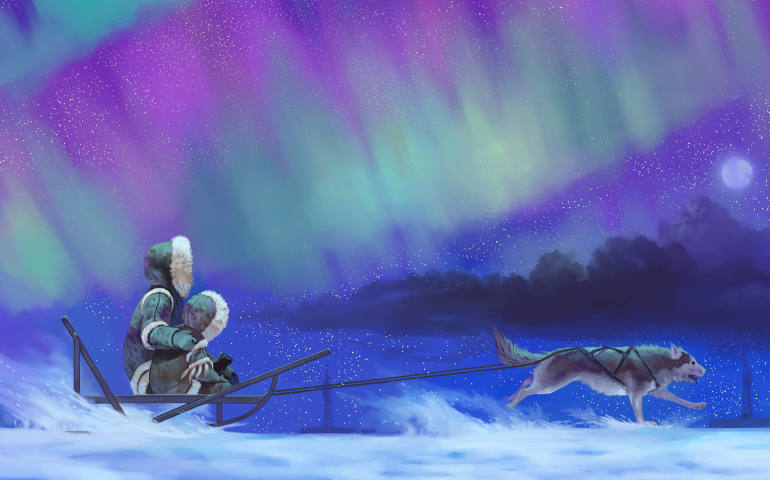
A scene from "Christmas Nevermore" shows Inuit children Polik and Nika sledding amid the Northern Lights. (Illustration by Christina Zakhozhay)
Looking for a last-minute Christmas book to place alongside The Lorax and other environmental “keeper” books on your shelf?
Two new publications -- Christmas Nevermore by Marc Cadieux and Herve Bastien, and Mert the Anxious Evergreen, by Claire Bowman -- revisit the spirit of Dr. Seuss’ cautionary tale about corporate greed and environmental degradation, and all within a holiday-season setting.
Although their themes appear dark, both stories offer imaginative, often humorous solutions that will inspire and delight every youngster from ages eight to 95 and above. Not just for children, these ecological tales offer important messages to adults, too: from the environmentally conscious, to those who’ve lost their childlike imagination, to fossil-fuel and land-development supporters.
Whoever reads these stories will find a common scenario: The villains regret what they have done. They admit defeat, and realize that environmental care must become primary on the planet’s universal “to do” agenda.
In Christmas Nevermore the epiphany comes to Jack, the angry, knife-wielding manager of Big Oil’s new site in the Inuit village of Akilineq at the North Pole. Seething after a series of misfortunes -- the company’s pipeline plugged with presents and wrapping paper; his crew drilling’s causing environmental havoc in the watery sanctuary of the Inuit goddess Mother of the Sea as well as damaging Santa’s underground ice caves -- Jack, on the cusp of arrest for holding two employees captive, admits the periling effects the drilling has on the Earth.
“The shareholders always want more ... they squeeze us like lemons,” he says. “… The proof is all of the stupid things I’ve managed to do myself. One day it will be too late, much too late, for our children and grandchildren.”
A similar moment of clarity reaches Mr. Upton in Mert the Anxious Evergreen. A Ripley Heights realtor, Upton is intent on purchasing Old Joe Greenwood’s Hickory Flats family tree farm and forest for development. But before he cashes in on the project, he rips up the already signed contract, seeing for the first time in his profit-driven life the luminous forest for what it really is.
The trees sing to Upton, who hears “their subtly exquisite music.” Joining in the chorus are Mert, the young tree protagonist intent on spreading the Christmas spirit and saving the forest, his cat pal, John, Mert’s mother and even the stars and the moon.
After the music fades away, Upton admits, “Mr. Greenwood, I am sorry I had not realized how precious all of this was.”
Adding to the story’s compelling plots are the illustrations: in Christmas Nevermore the beautiful drawings of the North Pole by Russian illustrator Christina Zakhozhay, and in Mert, Bowman’s depictions of the darling little evergreen and his friends, exuding such energy they jump off the page into the reader’s arms.
In an email interview Cadieux, a filmmaker along with Bastien, explained the vision behind Christmas Nevermore, including why each page is bordered in a black frame: “For me, black represents oil and pollution. Because let’s face it, if we don’t all act soon, black is all we’ll be seeing. … Even the ice caps are turning black.”
In the story Polik and Nika, two orphaned, mixed-race Inuit children, team with Santa and his elves to encourage children worldwide to hide their parents’ car keys and keep them off the roads for 10 days. Cadieux said the idea came from reality, where efforts in Athens and China have had people with even-numbered license plates drive on even-numbered days, and vice versa.
“Imagine that if for 10 days cars, buses, planes factories stopped operating on a worldwide scale. This would have a definite impact on the planet,” he told NCR.
The tactic is a good beginning, although, Cadieux notes and as Santa points out in the story, much more has to be done on a long-term, permanent basis.
Another tactic from the story -- where Santa asks the Mother of the Sea to send cascades of steam from a nearby volcano into the atmosphere to form a protective shield -- also draws inspiration from real-world projects, where researchers are in the early stages of developing a mechanism to pump steam into the atmosphere.
“But instead of using a machine we thought why not use something natural -- like a volcano’s heat combined with water and ice to get a vapor shield,” Cadieux said.
The Canadian-born filmmaker said he hopes that the message of the book “will remind people of the importance of family, culture and protecting the world that we live in for years to come.”
He continued: “By posing the question, ‘what if Christmas ceased to exist?’ my book highlights climate change and the sometimes damaging effects of industry in an innovative way that kids can relate to.”
A portion of the book's sales will go to Sanctuary for Kids, a non-profit that aims to protect and improve the lives of children in crisis areas around the world.
How Mert the Anxious Evergreen came to life grew from a little seedling inside its author’s creative psyche since childhood. Before studying studio art at Maryland’s College of Notre Dame and the Maryland Institute of Art and psychology at Johns Hopkins University, Bowman said she “always tended to see ‘being’ in things, even inanimate things like evergreen trees, ever since I was a kid.”
A Renaissance woman who -- along with writing -- draws, paints, sings with her twin sister, composes, gardens and composts, Bowman, raised Catholic in Iowa, says she has had to defend on occasion a primary storyline of the book: the townsfolk’s defense of the farm and forest.
“[One reader] felt it was unrealistic that a farmer would keep a grove of trees on his land, let alone a forest, for it took the land out of profitable service,” Bowman recalled.
“People don’t always grasp that nature has inherent value beyond its usefulness,” she said, acknowledging that the writing of Mert is “more about how things could be than about how things are.”
Both Christmas Nevermore and Mert the Anxious Evergreen capture the fragile preciousness of our home planet with insight and beauty, combined with smashing good plots. One closes the final pages of each with a warm heart and spirit, reminded again, of what goodness and compassion can accomplish when they are linked to perseverance.




